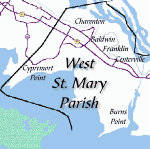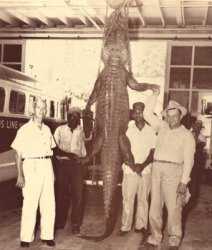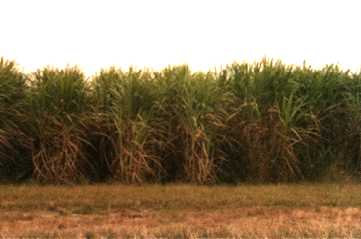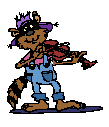 |

 My home is in west
St. Mary Parish, a very rural area right in the heart of
My home is in west
St. Mary Parish, a very rural area right in the heart of  Acadiana.
The Parish of St. Mary actually extends all the way to Amelia, but it is
physically divided by the Calumet Cut. I'm afraid that the division
is also a mental one, in the minds of many of the people here.
Without condoning or condemning
that point of view, I am limiting the focus of this site to the west end
of the parish. This is not a political or a social decision, it is
simply a practical decision based on the fact that there is only one of
me. West St. Mary is my home, it is the area I am most familiar with,
and the area that I have greatest access to. I tried to do the whole
parish, but I just can't keep up.
In the unlikely event
that I ever get this site 'complete' I may go ahead and do the east end,
too. Until then, welcome to west St. Mary Parish. Acadiana.
The Parish of St. Mary actually extends all the way to Amelia, but it is
physically divided by the Calumet Cut. I'm afraid that the division
is also a mental one, in the minds of many of the people here.
Without condoning or condemning
that point of view, I am limiting the focus of this site to the west end
of the parish. This is not a political or a social decision, it is
simply a practical decision based on the fact that there is only one of
me. West St. Mary is my home, it is the area I am most familiar with,
and the area that I have greatest access to. I tried to do the whole
parish, but I just can't keep up.
In the unlikely event
that I ever get this site 'complete' I may go ahead and do the east end,
too. Until then, welcome to west St. Mary Parish.
 The Parish Seat, Franklin,
is my home town and boasts a tiny population of 9,000.
St. Mary Parish has a
population of about 58,000. Though it does get cold here sometimes
(it snows a couple times a decade) our average temperature is around 70
degrees F. We get a LOT of rain, about 69 inches per year.
The Parish Seat, Franklin,
is my home town and boasts a tiny population of 9,000.
St. Mary Parish has a
population of about 58,000. Though it does get cold here sometimes
(it snows a couple times a decade) our average temperature is around 70
degrees F. We get a LOT of rain, about 69 inches per year.
 Things are different here,
as I've said about Louisiana, but down here, things are REALLY different!
Things are different here,
as I've said about Louisiana, but down here, things are REALLY different!
 Lots
of people look forward to hunting Alligator every year. This year,
the hunting has been very good!
At
one time, Alligators were on the endangered species list, and it was very
illegal to kill one. This posed a bit of a problem, since they were
never really scarce here. Many stories are told of people finding
a big ol' gator on their patio, or back yard. Pets have been eaten
by the giant reptiles, and occasionally, people have been attacked.
I'm talking about in town, not in the woods or the swamps.
(out there, you take your chances)
Since it is now legal
to hunt them, in season and with restrictions, it's not so common to see
them in town.
Which is not to say that
it is uncommon. A gator, usually a small one, is removed from
a Bayou in a town at least once or twice a year. If you look carefully
as you drive along Hwy 182 or Hwy 87 in the summertime, you might well
spot one.
The Egrets (sometimes
pronounced E-gray), Lots
of people look forward to hunting Alligator every year. This year,
the hunting has been very good!
At
one time, Alligators were on the endangered species list, and it was very
illegal to kill one. This posed a bit of a problem, since they were
never really scarce here. Many stories are told of people finding
a big ol' gator on their patio, or back yard. Pets have been eaten
by the giant reptiles, and occasionally, people have been attacked.
I'm talking about in town, not in the woods or the swamps.
(out there, you take your chances)
Since it is now legal
to hunt them, in season and with restrictions, it's not so common to see
them in town.
Which is not to say that
it is uncommon. A gator, usually a small one, is removed from
a Bayou in a town at least once or twice a year. If you look carefully
as you drive along Hwy 182 or Hwy 87 in the summertime, you might well
spot one.
The Egrets (sometimes
pronounced E-gray),  those long legged white
birds, have made a real comeback. When I was a child, it was very
uncommon to see one. You had to go to a sanctuary, like Avery Island,
to find any.
I remember, about 20 years
ago, one flew into our neighborhood and rested in a tree in our yard.
It was a major event! Now they are everywhere! It is still exciting
to spot a Snowy Egret, a somewhat smaller Egret with fuzzy feathers.
They look like a regular Egret having a bad hair day!
The Gators and Egrets
were "endangered" by the use of chemicals, mostly. All of the
Chemicals that farmers spray, all of the junk that gets dumped into the
inland waters, all of the stuff that washes away from all over the Eastern
US . . . it all ends up here, at the mouth of the Mississippi.
In that regard, those of us who live and work here have little control
over the protection of our special "neighborhood."
Since the use of certain
chemicals has been banned all over the country, the native animals of our
swamps and marshes have made a big comeback.
those long legged white
birds, have made a real comeback. When I was a child, it was very
uncommon to see one. You had to go to a sanctuary, like Avery Island,
to find any.
I remember, about 20 years
ago, one flew into our neighborhood and rested in a tree in our yard.
It was a major event! Now they are everywhere! It is still exciting
to spot a Snowy Egret, a somewhat smaller Egret with fuzzy feathers.
They look like a regular Egret having a bad hair day!
The Gators and Egrets
were "endangered" by the use of chemicals, mostly. All of the
Chemicals that farmers spray, all of the junk that gets dumped into the
inland waters, all of the stuff that washes away from all over the Eastern
US . . . it all ends up here, at the mouth of the Mississippi.
In that regard, those of us who live and work here have little control
over the protection of our special "neighborhood."
Since the use of certain
chemicals has been banned all over the country, the native animals of our
swamps and marshes have made a big comeback.
 Now
the issue is the Black Bears. They are the endangered species
of the moment. Like the 'gators, they are not uncommon here.
In the summer, it's not uncommon for law enforcement to be called out to
deal with a bear in a neighborhood that needs to be relocated, or
bears on the highway in danger of getting hit (and causing injury to whoever
might hit it), and at least one that did get hit! What a commotion!
They had to get the Coroner out to declare the bear dead.
I hope they get off the
list soon!
Obviously, SMP is Very
Rural. Now
the issue is the Black Bears. They are the endangered species
of the moment. Like the 'gators, they are not uncommon here.
In the summer, it's not uncommon for law enforcement to be called out to
deal with a bear in a neighborhood that needs to be relocated, or
bears on the highway in danger of getting hit (and causing injury to whoever
might hit it), and at least one that did get hit! What a commotion!
They had to get the Coroner out to declare the bear dead.
I hope they get off the
list soon!
Obviously, SMP is Very
Rural.
 It is not all woods and
swamp and marshes, though. West St. Mary is a very agricultural area.
Our main crop is sugar cane. Fields of the tall grass may look uncared
for to tourists, but to us it is a sweet sight indeed.
It is not all woods and
swamp and marshes, though. West St. Mary is a very agricultural area.
Our main crop is sugar cane. Fields of the tall grass may look uncared
for to tourists, but to us it is a sweet sight indeed.  Sugar cane is a bit of an odd crop. The growing season is actually
longer than a year, so cane farmers start planting next years crop before
they start harvesting this years. It is not unusual, in the fall,
to see two fields of cane side by side, one much taller than you are, the
other not quite knee high. By some system, which I don't pretend
to understand, they manage to have a crop ready for harvest at the same
time they are tending new plants.
Harvesting the cane is
a mess! Until very recently, the cane was harvested by burning the
fields! I think this season will be the first season that this is
not allowed. Although it is a beautiful sight, I suppose it is not
very good for the enviorment, and it has been known to be a bit dangerous.
Now, new machines cut and harvest the cane while it is standing.
Whether the cane is burned or just cut, it is piled into wagons or trailers
and hauled to the sugar mill for processing. The mud that gets dragged
onto the roads is unbelievable.
If you visit in the fall,
during Grinding, beware the slow moving tractors. It seems like someone
gets seriously hurt every year as a result of an accident involving a cane
tractor.
Sugar cane is a bit of an odd crop. The growing season is actually
longer than a year, so cane farmers start planting next years crop before
they start harvesting this years. It is not unusual, in the fall,
to see two fields of cane side by side, one much taller than you are, the
other not quite knee high. By some system, which I don't pretend
to understand, they manage to have a crop ready for harvest at the same
time they are tending new plants.
Harvesting the cane is
a mess! Until very recently, the cane was harvested by burning the
fields! I think this season will be the first season that this is
not allowed. Although it is a beautiful sight, I suppose it is not
very good for the enviorment, and it has been known to be a bit dangerous.
Now, new machines cut and harvest the cane while it is standing.
Whether the cane is burned or just cut, it is piled into wagons or trailers
and hauled to the sugar mill for processing. The mud that gets dragged
onto the roads is unbelievable.
If you visit in the fall,
during Grinding, beware the slow moving tractors. It seems like someone
gets seriously hurt every year as a result of an accident involving a cane
tractor.
 MORE TO COME
MORE TO COME

LinkExchange
Member

Send comments or suggestions to:
Cheri', sundry@bigfoot
Copyright © 1997 1998 Cheri'
|

 Acadiana.
The Parish of St. Mary actually extends all the way to Amelia, but it is
physically divided by the Calumet Cut. I'm afraid that the division
is also a mental one, in the minds of many of the people here.
Acadiana.
The Parish of St. Mary actually extends all the way to Amelia, but it is
physically divided by the Calumet Cut. I'm afraid that the division
is also a mental one, in the minds of many of the people here. Lots
of people look forward to hunting Alligator every year. This year,
the hunting has been very good!
Lots
of people look forward to hunting Alligator every year. This year,
the hunting has been very good!
 Now
the issue is the Black Bears. They are the endangered species
of the moment. Like the 'gators, they are not uncommon here.
In the summer, it's not uncommon for law enforcement to be called out to
deal with a bear in a neighborhood that needs to be relocated, or
bears on the highway in danger of getting hit (and causing injury to whoever
might hit it), and at least one that did get hit! What a commotion!
They had to get the Coroner out to declare the bear dead.
Now
the issue is the Black Bears. They are the endangered species
of the moment. Like the 'gators, they are not uncommon here.
In the summer, it's not uncommon for law enforcement to be called out to
deal with a bear in a neighborhood that needs to be relocated, or
bears on the highway in danger of getting hit (and causing injury to whoever
might hit it), and at least one that did get hit! What a commotion!
They had to get the Coroner out to declare the bear dead. Sugar cane is a bit of an odd crop. The growing season is actually
longer than a year, so cane farmers start planting next years crop before
they start harvesting this years. It is not unusual, in the fall,
to see two fields of cane side by side, one much taller than you are, the
other not quite knee high. By some system, which I don't pretend
to understand, they manage to have a crop ready for harvest at the same
time they are tending new plants.
Sugar cane is a bit of an odd crop. The growing season is actually
longer than a year, so cane farmers start planting next years crop before
they start harvesting this years. It is not unusual, in the fall,
to see two fields of cane side by side, one much taller than you are, the
other not quite knee high. By some system, which I don't pretend
to understand, they manage to have a crop ready for harvest at the same
time they are tending new plants.






